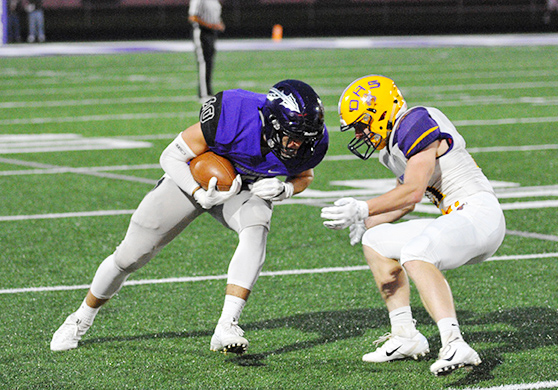Recovering from ACL injuries
The knee is an intricate part of the human body. Bones, muscles and ligaments work together to help athletes compete at the highest levels. Unfortunately, intense competition can sometimes lead to a torn anterior cruciate ligament (ACL), which connects the thighbone to the shinbone and helps keep the knee stable.
 According to a 2013 study by the Journal of Athletic Training, ACL injuries account for one-fifth of all knee injuries in high school athletes and are seven times more likely to happen in competition than in practice. The same study found that the highest rates of ACL injuries in high school sports occur in girls soccer (12.2 injuries per 100,000 athlete exposures), football (11.1) and girls basketball (10.3).
According to a 2013 study by the Journal of Athletic Training, ACL injuries account for one-fifth of all knee injuries in high school athletes and are seven times more likely to happen in competition than in practice. The same study found that the highest rates of ACL injuries in high school sports occur in girls soccer (12.2 injuries per 100,000 athlete exposures), football (11.1) and girls basketball (10.3).
Although several factors can contribute to an ACL injury, Dr. David Geier, orthopedic surgeon and author of “That’s Gotta Hurt: The Injuries That Changed Sports Forever,” said more females playing sports is causing ACL injury numbers to rise.
“They are at a much higher risk for ACL tears,” Geier said. “There are a lot of theories. The one that seems to hold the most weight is a neuromuscular difference between males and females in terms of how men and women land with their knees and how they turn.
“Guys land with better balance with their hips and knees in better position and use the right muscles appropriately. The good news about that is that you can train those things and decrease the rate, some people say, between 40 and 70 percent. All of that is potentially fixable, but it requires work.”
Female athletes tear their ACL 3.5 times more in basketball and 2.67 times more in soccer than their male counterparts, according to a 2007 Arthroscopy study.
Marc Sherry, physical therapist and manager of sports rehabilitation for University of Wisconsin Health at the American Center, agreed with Geier. She said there also are extrinsic injury causes such as specialization, training surfaces, fatigue, preparation and strength training.
“The thought is that sport specialization creates an athlete that is adapted to one specific movement and makes them less adaptable to unanticipated changes in those normal movement patterns,” Sherry said. “That could potentially make them more susceptible to ACL injuries.”
ACL injury rehab
Sherry warned that high school and college athletes should not compare themselves to professional athletes when it comes to rehabbing injuries.
“When (professionals) become injured, their job is now rehab,” Sherry said. “We’re asking high school and youth athletes to rehab an hour a day. A lot of times, these professional athletes are rehabbing several hours a day with other recovery components. It’s definitely a different level.”
Don’t push it just because you’re trying to play in a certain game or a certain tournament.
Although some athletes can return to play after six months, most will probably have a better chance nine to 12 months after surgery, Geier said.
“We like the athletes to kind of get back to normal and not just have full motion and strength,” Geier said. “It’s a completely different animal in terms of getting good enough to be able to play. It’s a lot of work with a physical therapist, getting knee motion back and getting strength back. Early on, it’s very tedious and aggravating.”
Sherry said it’s critical that athletes get their knee straightening or knee extension back right after surgery. He said 15 to 20 years ago, doctors would brace or cast an injured athlete with their knee partially bent because they thought it accelerated the healing process. Over time, they discovered it created more problems.
After that, athletes can get back to sport-specific drills. A soccer player might kick the ball while balancing on the injured leg. A basketball player might pivot and cut, or start doing layups and jump shots off the injured leg.
Sherry said clearance to participate in sports means that the athlete has no restrictions and can perform at 100 percent. At UW Health Sports Medicine at the American Center, there is an indoor and outdoor turf field and a basketball court for the final stages of rehab.
“If you’re doing all of your rehab in a very sterile, isolated environment, then you go back to the basketball court and the last time you were there, you sustained your ACL injury, it’s sort of like going back to the scene of a crime,” Sherry said. “The fear and apprehension is a lot greater.
“There was a study out of the University of Florida that looked at athletes who were one year out of an ACL reconstruction who had not returned to sport yet and they analyzed all the potential different factors for that — pain, swelling, weakness. When all of the factors were analyzed, the one that was the most common was fear and apprehension.”
Avoiding re-injury
According to a 2012 study in the American Journal of Sports Medicine, 63 percent of high school football players and 69 percent of college players successfully returned to the field after surgery. The highest probability of ACL reconstruction failures occurs in 10- to 19-year-olds, with up to 37.5 percent of the grafts tearing in the first couple of years after surgery, a 2011 Sports Health report found.
“I don’t know that you can ever completely eliminate that risk,” Geier said. “We think that about 20 percent of people either tear the surgical knee or tear the ACL on the opposite side. I think learning those exercise programs as part of your rehab and getting your mechanics fixed lowers that chance, but it can still happen.
“Don’t try to come back too soon if the doctor or physical therapist doesn’t feel like you’re ready. Don’t push it just because you’re trying to play in a certain game or a certain tournament.”
Sherry said that once an athlete returns to action, the doctor or therapist tailors a program for them to continue over time.
“We ask them to do something for 10 to 15 minutes at the end of practice three times a week,” Sherry said. “Usually it’s individualized to the athlete, but it’s back to the similar concepts of the ACL prevention programs: balance training, jump landing training, agility and movement control.”
Sherry said he believes there are examples that show the athlete can get back to their usual self.
“Sometimes people can get back to a higher level, but if you look at the statistics, that’s not the norm,” Sherry said. “The reality is that 25 to 30 percent of the people (who had surgery) do not get back to their preinjury level for some reason or another.”
Geier said the athlete might lose some explosiveness and power, but not necessarily all the time.
“I don’t tell people that to discourage them,” Geier said. “I tell them that to motivate them and have them work even harder.”





